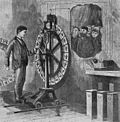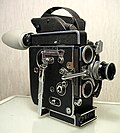Movie
A movie or film is a type of visual art that uses images and sounds to tell stories, express ideas, or teach people something. Most people watch movies to entertain themselves or to have fun. Movies can vary significantly in emotional tone both overall as a specific genre type but also within a single work. Some of the most typical approaches are to make people laugh (comedy), make them cry (tragedy or drama), or make them feel afraid (horror). However, there are also movies that combine genres, like horror-comedy.
Overview

Most movies are made so that they can be watched at home or on a movie screen at movie theaters. Movies are shown in movie theaters a few weeks or months after or before the movie is released. Movies can be marketed using media. Movies are shown on paid television or cable television or are sold or rented on DVD disks or videocassette tapes so that people can watch the movies at home. Movies can also be downloaded or streamed. Some movies are shown on television broadcasting stations.
Movies are filmed with movie cameras or video cameras. Movie cameras take pictures very quickly, usually 24 or 25 pictures or frames every second. When a movie projector, a computer, or a television shows the pictures at 24 frames a second, it looks like the things shown in the set of pictures are moving. Sound is usually recorded at the same time as the pictures are, but sometimes, they are added later. The sounds in a movie are usually people talking, the soundtrack, and sound effects. In the 20th century, the camera used photographic film.
Making movies
Most movies start to be made when a screenwriter writes a script, which is the story of the movie with dialogue and words and things that the actors will say and do. A producer hires people to work on the movie and gets the money that will be used to pay for the actors, or actresses, and the equipment. Producers usually get the money by borrowing it from a bank or by asking investors to give money to them. Some producers work for a movie studio, but other producers work by themselves.
Actors, or actresses, and directors read scripts to learn what to say and what to do. The actors learn the words from the script that they will say in the movie and learn the things that the script tells them to do. Then, the director tells the actors what to do and a cameraman takes the film of them saying the words with a film camera.
When the filming is done, an editor makes the film play after each other, which makes a story. Audio engineers and sound engineers record music and singing and combine it with the film. When the movie is done, many copies of the movie are made by movie labs and put onto film reels. Then, the reels are sent to movie theaters. A projector shines a very bright light through the film, and people sitting in a dark room see it on a big screen.
Types
A
A genre means a type of movie. Movies can be fictional or non-fictional. Some movies can be two or more genres.
- Action movies are movies where the main character is in a dangerous situation, and there is usually a lot of violent scenes, such as explosions, blood, and fighting scenes. In Die Hard, terrorists take control of a skyscraper and ask for a big ransom. If they are given the ransom, they won't kill the people who work in the skyscraper, who are called hostages.[2]
- Adventure movies usually have a hero who go on long journeys to fight big things, like dragons.
- Animated movies use drawn images like cartoons to tell a story. These movies used to be drawn by hand, one frame at a time, but they are usually now made on computers. They can be 2D animated or 3D animated.[2]
B
C
D
- Documentaries are non-fiction movies that are (or claim to be) about real people and real events. They are nearly always serious and may involve strongly emotional subjects, for example cruelty.
- Dramas are serious and often about people falling in love or needing to make a big decision in their life. They tell stories about relationships between people. They usually follow a basic plot where one or two main characters (each actor plays a character) have to 'overcome' (get past) an obstacle (the thing stopping them) to get what they want.
F
H
- Horror movies use fear to excite the audience. Music, lighting and sets (man-made places in movie studios where the movie is made) are all designed to add to the feeling.
R
- Romantic Comedies, also called "Rom-Com"s are usually stories about two persons falling in love and doing funny things or have funny things happen to them.
S
T
- Suspense movies makes the audience stressed. They usually have multiple twists that confuse the people watching the movie
- Thrillers are usually about a mystery, strange event, or crime that needs to be solved. The audience is kept guessing until the final minutes, when there are usually 'twists' in the plot (surprises).
- Tragedies are a type of drama. They are about people in trouble. For example, a husband and wife who are divorcing must each try to prove to a court of law that they are the best person to take care of their child. Emotions (feelings) are a big part of the movie, and the audience (people watching the movie) may get upset and even cry.
W
- War is a movie genre concerned with warfare. They are normally about naval, air or land battles. They have combat scenes central to the story. These stories are most commonly set in the 20th century.
- Western movies tell stories about cowboys in the western United States in the 1870s and 1880s. They are usually action movies but with historical costumes. Some involve Native Americans. Not all movies that are set in the American West are made there. For example, Western films made in Italy are called Spaghetti Westerns. Some films can also use Western plots even if they are set in other places.
Business of making movies
Most movies lose money, but some make up to hundreds of millions or billions of dollars. In the United States, movies have become an enormous part of the economy. The industry has always been led by a few major movie studios like MGM/UA, Warner Bros., Sony Pictures, Paramount, or Disney. The oldest American movie studio is Universal.
Elements
There are many large companies that provide all of the services needed to make movies, such as special effects, lighting, and set building companies. Many of these employees belong to trade unions who say how much their members must be paid. A large number of smaller companies also offer services, such as music studios, which record music.
Distribution
Finally, there are movie distribution companies and advertising companies. Movies with famous stars (actors who are well-known) and large budgets, are designed to have a large appeal (something a person would like about the, so that hopefully, millions of people will pay to see them. The most expensive movies are called blockbusters.
Special effects can add a huge amount to the cost of a movie, especially if the movie uses the newest CGI effects. However, people have come to expect them, and every blockbuster movie tries to outdo the last. Even in 2008, some movies can cost up to $200 million to make.
Very successful movies can make many times that amount in profit, and that's why the studios keep producing them. This kind of movie will have a lot of promotion through television advertising, billboards and internet sites.
Blockbuster
In blockbuster movies, there is usually a happy ending, in which all of the problems in the plot (story) are figured out or fixed and almost everyone (except the bad guys) live happily ever after. Some movies have been so successful that the studios keep releasing more and more sequels or movies with the same characters and basic plots.
Indie films
At the opposite end of the scale to the blockbuster, there is the independent, art, or Indie movie. These are usually made by small movie companies, or even just a small group of people that do not have much money. An example is The Blair Witch Project, which cost only about $60,000, but which has so far taken perhaps $200 million in ticket and DVD sales. Movies like this are very unusual and usually become popular 'underground' (word of mouth advertising), so that they have a cult following, or popular but not mainstream.
Independent movies often tell more creative or unusual (strange) stories or may have sad endings that do not appeal to the big studios because they cannot be sure how the public will react to them. They rarely make a lot of money, but if they are successful, the big studios will quickly try to get the people involved to sign a contract with them, by offering them a lot of money to make another movie.
The Oscars
Some movies receive Oscar nominations, which normally reflect on the qualities of a film's production process. Also, some actors and actresses receive Oscar nominations and wins.
Age-appropriate ratings
Movies are rated by their age appropriateness. Some examples include G, PG, PG 13, and R.
Movie Media
A Trip to the Moon (1902) is considered to be a turning point in the development of narrative and science fiction films.
An Anschütz electrotachyscope American Scientific, 16/11/1889, p. 303
Pauvre Pierrot (1892) repainted clip
A clip from the Charlie Chaplin silent film The Bond (1918)
Sound in cinema started gaining acceptance with movies like The Jazz Singer (1927)
Salah Zulfikar, one of the most popular actors in the golden age of Egyptian Cinema.[source?]
This 16 mm spring-wound Bolex "H16" Reflex camera is a popular entry level camera used in film schools.
Related pages
- Big Ten (movie studios), America's ten largest movie studios
References
- ↑ "Empire Features". 2012-01-18. Archived from the original on 2012-01-18. Retrieved 2022-06-24.
- ↑ 2.0 2.1 "90+ Film Genre Examples for Film & TV". StudioBinder. 2020-12-13. Retrieved 2021-02-25.
Other websites
| Wikimedia Commons has media related to Lua error in Module:Commons_link at line 62: attempt to index field 'wikibase' (a nil value).. |



